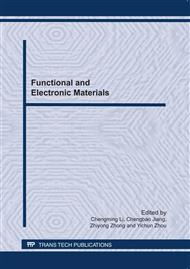p.576
p.580
p.585
p.591
p.596
p.602
p.610
p.617
p.621
Conversion of Surface Energy and Experimental Investigation on the Self-Motion Behaviors of Liquid Droplets on Gradient Surfaces
Abstract:
A surface with surface energy gradient was fabricated by using a controlled photodegradation technique of a fluoroalkylsilane self-assembled monolayer (SAM) using irradiation of vacuum ultraviolet light (wavelength=172 nm). Visualization experiments were carried out to investigate the motion behaviors of water droplets on horizontal gradient surfaces. System free energy conversion was analyzed to understand the mechanics of the droplet self-motion. The results show that the liquid droplets were self-propelled to move from hydrophobic region to hydrophilic region on horizontal gradient surfaces. The motion process of the water droplet experienced an accelerating stage and a decelerating stage. The velocity of 2 mL water droplet reached to a maximum of 23.28 mm/s. In the droplet motion on the horizontal gradient surface, the deformation and spread of the droplet continuously release out the interfacial and gravitational potential energy, which offers the kinetic energy for the droplet motion. However, the released interfacial energy is three orders of magnitude larger than the released gravitational potential energy. Thus, the released interfacial energy is the main source of driven energy for the droplet motion. The theoretical analysis is consistent with the experimental results.
Info:
Periodical:
Pages:
596-601
Citation:
Online since:
June 2011
Authors:
Price:
Сopyright:
© 2011 Trans Tech Publications Ltd. All Rights Reserved
Share:
Citation:


